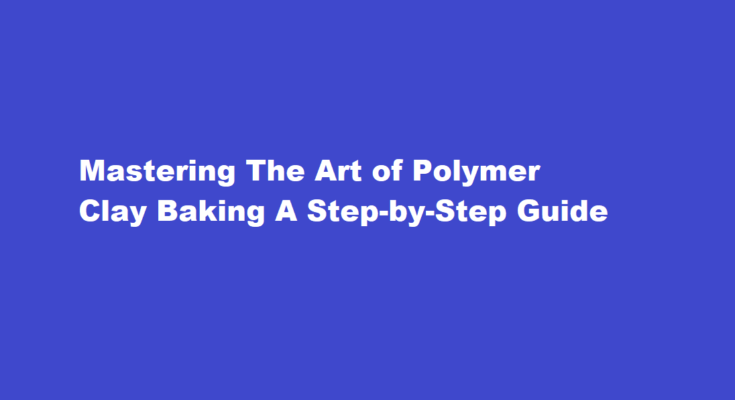Introduction
Polymer clay is a versatile and popular medium for crafting intricate sculptures, jewelry, and decorative items. To achieve the best results, proper baking is essential. In this comprehensive guide, we will walk you through the steps of baking polymer clay to ensure your creations come out beautifully and last for years to come.
Choosing the Right Polymer Clay
Selecting high-quality polymer clay is the first step towards successful baking. Brands like Fimo, Sculpey, and Premo are renowned for their consistency and vibrant colors. Ensure your clay is soft and pliable, free from cracks or dryness, which could compromise the baking process.
Preparation and Design
Before you start, plan your design and assemble your tools. Polymer clay can be molded, carved, and textured to your desired shape. Remember to create a base for your piece to prevent direct contact with the baking surface, ensuring a smooth finish.
Oven and Temperature
Polymer clay must be baked in a dedicated oven to prevent any fumes from affecting your home oven. A countertop toaster oven or a dedicated polymer clay oven is ideal. Preheat the oven according to the manufacturer’s instructions, generally between 225°F to 275°F (107°C to 135°C) for 15-45 minutes.
Baking Time
The baking time depends on the thickness and size of your piece. Generally, bake for 15 minutes per 1/4 inch (6mm) thickness. Over-baking can lead to discoloration or brittleness, while under-baking may result in a weak structure. Use an oven thermometer to ensure accuracy.
Baking Surface and Covering
Place your piece on a baking surface like a ceramic tile or a piece of glass to ensure even heat distribution. Cover the piece with a tent of aluminum foil or a heat-resistant barrier to prevent direct contact with the oven’s heating elements.
Avoiding Color Changes
To prevent color shifts during baking, cover your creation with a sheet of parchment paper. Lighter colors are particularly prone to darkening, so it’s crucial to keep them covered.
Cooling Process
Once the baking time is up, turn off the oven and let your piece cool gradually inside the oven. Rapid temperature changes can lead to cracking or warping. Patience is key during this stage.
Post-Baking Sanding and Buffing
After your piece has cooled, you may notice minor imperfections or rough spots. Gently sand the surface with fine-grit sandpaper and then buff it to a smooth finish using a soft cloth. This step enhances the final look of your creation.
Sealing for Protection
For jewelry and decorative items that will be handled frequently, consider sealing them with a clear varnish or glaze. This not only provides a protective layer but also enhances the colors and gives your piece a professional finish.
FREQUENTLY ASKED QUESTIONS
Can you bake polymer clay in a regular oven?
You can use your regular home oven – it’s perfectly safe. You don’t need to buy a dedicated clay oven or kiln. If you don’t have a regular home oven, you can use a toaster oven. If you want to use a toaster oven, choose a model that can hold a steady, accurate temperature — we’ll talk about this more below.
Is polymer clay food safe?
Yes. It is perfectly safe to bake your clay in the oven in which you prepare your food. When used as directed, polymer clays do not give off toxic chemicals in the curing process. There is a slight odor, which is not harmful.
Conclusion
Baking polymer clay is a skill that requires patience and attention to detail. By following these steps, you can create stunning sculptures and jewelry that are durable and long-lasting. Remember that experimentation is key, and with practice, you’ll develop a sense of the ideal baking conditions for your specific projects. So, gather your polymer clay, design your masterpiece, and embark on a creative journey that will yield beautiful results.
Read Also : Mastering Data Mapping in Excel A Comprehensive Guide



